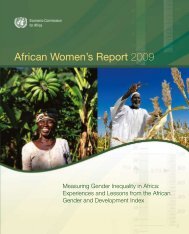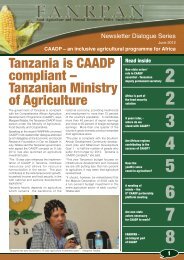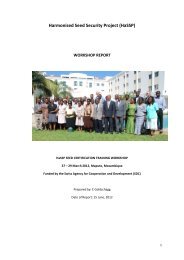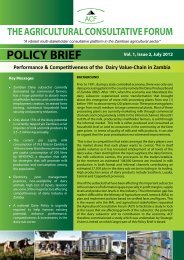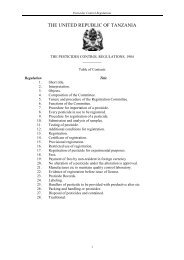Community-driven development decision tools for rural - IFAD
Community-driven development decision tools for rural - IFAD
Community-driven development decision tools for rural - IFAD
- No tags were found...
You also want an ePaper? Increase the reach of your titles
YUMPU automatically turns print PDFs into web optimized ePapers that Google loves.
<strong>IFAD</strong>’s CDD projects do not need government to share the second view about CSOs of publicutility. Nevertheless, this view is of particular interest to <strong>IFAD</strong> as it facilitates CBOs’ role as partners ofpublic utility CSOs. This may be a particularly effective way to enhance the participation andempowerment of the Fund’s target group in the <strong>development</strong> process. <strong>IFAD</strong> projects have beeninstrumental in several countries in <strong>for</strong>ming CSOs with a strong community basis, establishingpartnerships between CBOs and NGOs with strong public utility functions, and negotiating the<strong>for</strong>mal recognition of their “public utility” in the countries’ legislation. 19Partnerships between CBOs and NGOsWould supporting strong partnerships between CBOs and NGOs weaken or strengthen the localgovernment? There are two views on this matter.One argues that developing autonomous organizations which bypass the local government isoften contrary to the constitutional decentralization measures enacted by government and weakensthe process of implementing such measures because it diverts resources that should be used toincrease the capacity of the local administration. Accordingly, publicly-funded CDD should becarried out through and by the local government administration, not in competition with it.The other view maintains that complementarity and healthy competition, promoted bydistinguishing roles and mandates, does ultimately strengthen decentralization and enhances theemergence of effective local governments. This happens because• the local government’s limited resources are focused on the areas which are its mandate,increasing the chances of good per<strong>for</strong>mance (e.g. en<strong>for</strong>cing rules about standards, preparingmaster plans and implementing the larger public investments of the master plans, rather thanmaking investment <strong>decision</strong>s on small projects at the community level);• competition <strong>for</strong>ces better per<strong>for</strong>mance and more responsiveness from the local governmentthan does a monopolistic position.Assigning roles through devolution and delegationRoles are assigned by central governments through delegation and devolution. The <strong>for</strong>m andcontent of these instruments are very relevant to the design of CDD projects.Many public administration re<strong>for</strong>ms carried out since the mid-1990s in developing countrieshave devolved to the district level matters that affect agriculture and <strong>rural</strong> <strong>development</strong>, includingresponsibility <strong>for</strong> <strong>rural</strong> roads, irrigation, water supply, local market infrastructures, primaryeducation and basic healthcare facilities. District governments have been given different degreesof <strong>decision</strong>-making power in those fields and different <strong>for</strong>ms of resource transfers have beenintroduced to enable the districts to carry out their responsibilities.Experience with the impact of district-level decentralization on <strong>rural</strong> poverty is far fromconclusive. Central government’s genuine goals may be to reduce income disparities, improvegender equality and ensure household food security <strong>for</strong> all. However, measures to implementgovernment policies may conflict with the interests of groups at local levels that have a claim onusing public resources transferred to decentralized administrations and that have the politicalpower to seize those resources.District governments face significant problems in providing services that must be delivered at alevel higher than the village, so they place low priority on the community level. Rural roads,health centres and piped water supplies are examples of investments that are higher priorities <strong>for</strong>District Assemblies than village access tracks, village wells, microirrigation and functional literacy.The greater the number of villages in a territory, the greater “distance” between the districtadministrators and the communities and the more likely it is that the administrators are political19 See, <strong>for</strong> example, the case of the Programme de Développement Durable des Oasis in Mauritania and of the Programme deLutte Contre la Pauvreté Rurale in Cape Verde.39




